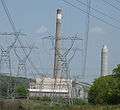Bull Run Fossil Plant
| Bull Run Fossil Plant | |
|---|---|
|
Bull Run Fossil Plant from north viewing area | |
| Country | United States |
| Location | Claxton, Anderson County, Tennessee, directly across the Clinch River (Melton Hill Lake) from Oak Ridge |
| Coordinates | 36°01′16″N 84°09′22″W / 36.02111°N 84.15611°WCoordinates: 36°01′16″N 84°09′22″W / 36.02111°N 84.15611°W |
| Status | Active |
| Commission date | 1967 |
| Owner(s) | Tennessee Valley Authority |
| Thermal power station | |
| Primary fuel | Coal |
| Type | ABB-CE coal-fired supercritical boiler |
| Feeding mines | Eastern Kentucky |
| Power generation | |
| Units operational | 1, General Electric cross compound turbine |
| Nameplate capacity | 950 megawatts |
Bull Run Fossil Plant, commonly known as Bull Run Steam Plant, is a 900-MWe coal-fired electric generating station owned and operated by the Tennessee Valley Authority.
Location
Bull Run Plant is located on 750 acres (300 ha), in the Claxton community of Anderson County, Tennessee, on the north bank of Bull Run Creek, directly across the Clinch River (Melton Hill Lake) from Oak Ridge, Tennessee.
History
Construction began on April 2, 1962 and was completed on June 12, 1967, when the plant began commercial operation.[1]
Units and operating parameters
The plant is the only single-generator coal-fired plant in the TVA system. The plant's winter net generating capacity is about 889 MWe.[2][3] The plant consumes 7,300 short tons (6,600 t) of coal per day,[1] and requires 2,900 metric tons (6,400,000 lb) of cooling water per hour. Its supercritical boiler operates at a pressure of 3,650 psi (248 atm) and temperature of 1,000 °F (540 °C).
Distinctions
When the generator first went into operation, it was the largest in the world (measured in terms of the volume of steam produced). Bull Run's heat rate (measure of the amount of heat used to produce a kWh of electricity) was the best of any plant in the United States in 1975, 1978, 1983, 1984, 1985, 1986, 1987, 1989, 1993, 1995, 2001, and 2004. Bull Run Fossil Plant named the most energy-efficient coal-fired power plant in the nation by Electric Light & Power magazine for calendar year 2001.
Environmental impact
In 2006, the plant ranked the 70th among the large coal-fired plants in the United States on the list of worst SO2 polluters, having emitted 11.92 lb (5.41 kg) of sulfur dioxide per MWh of energy produced (27,987 tons of SO2 in 2006 altogether).[4] [5] Since then, a wet limestone scrubber has been installed, which reduced sulfur dioxide emissions by about 95%.
-
.jpg)
Coal pile handling area
-

Bull Run power plant viewed from the west
-
Switchyard from viewing area
-
References
- 1 2 "Bull Run fossil plant". Tennessee Valley Authority. Archived from the original on August 15, 2007.
- ↑ "Existing Electric Generating Units in the United States, 2006" (Excel). Energy Information Administration, U.S. Department of Energy. 2006. Retrieved 2008-07-14.
- ↑ TVA's website lists the winter generating capacity as 870 MW Archived August 15, 2007, at the Wayback Machine.
- ↑ "Dirty Kilowatts 2007 Report Database". Environmental Integrity Project. Retrieved May 2008. Check date values in:
|access-date=(help) - ↑ "Technology Transfer Network: State Emission Index". U.S. Environmental Protection Agency. Retrieved May 2008. Check date values in:
|access-date=(help)